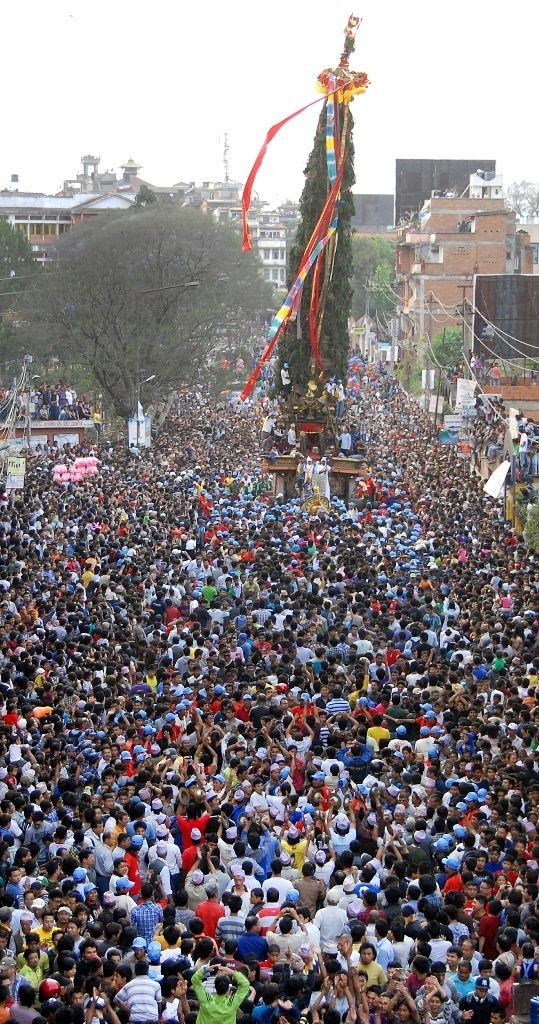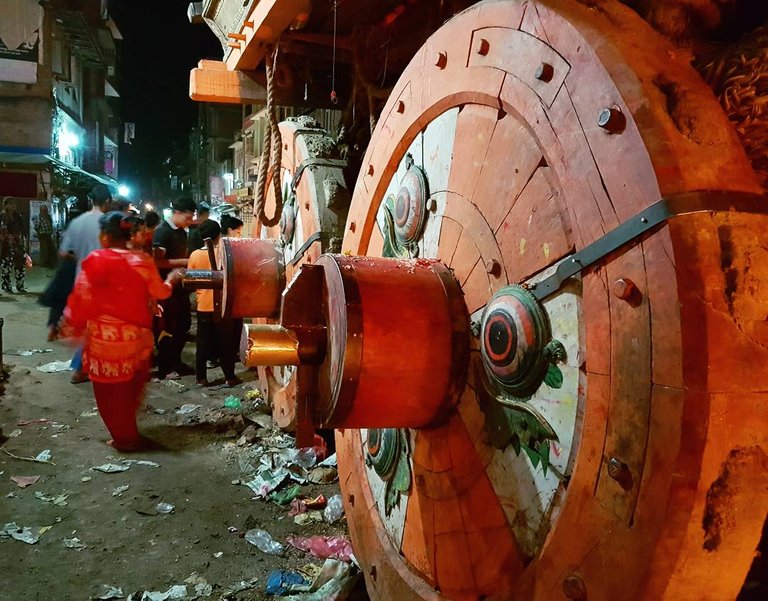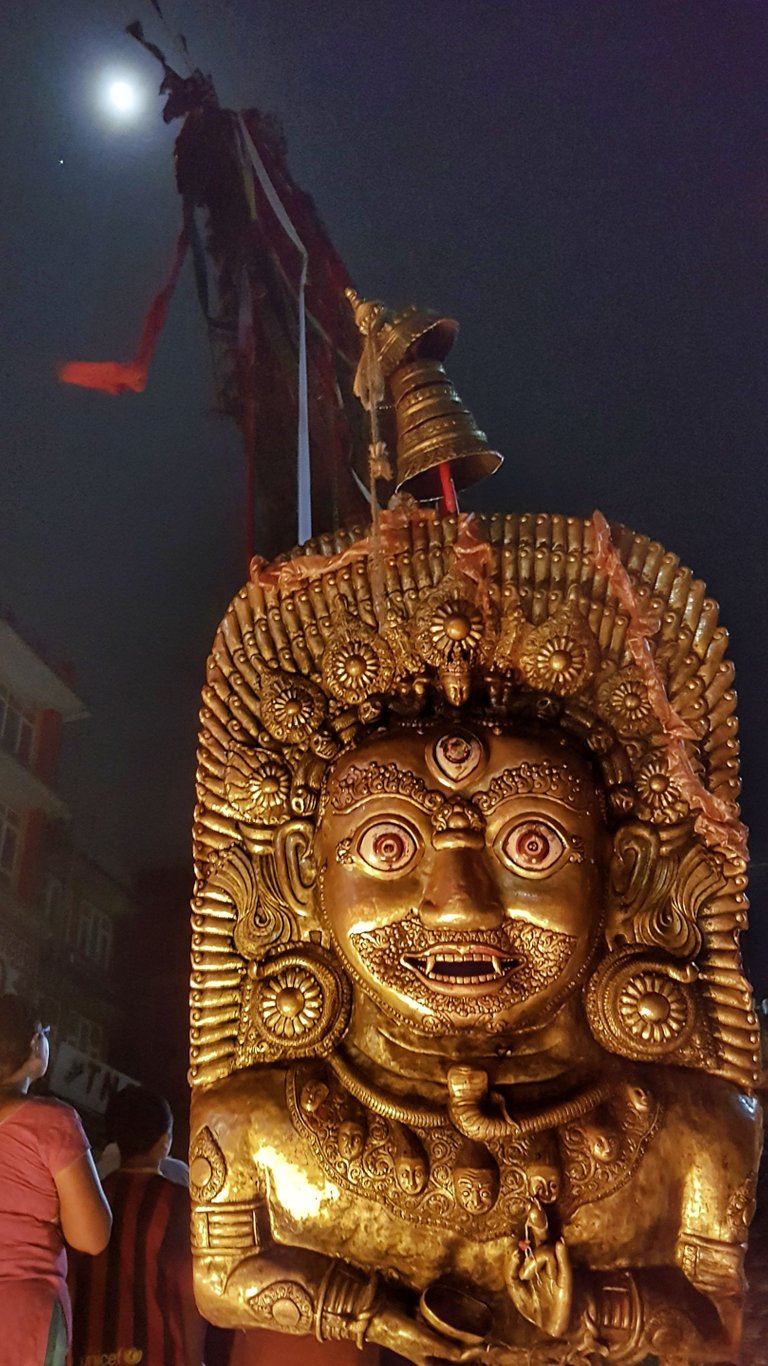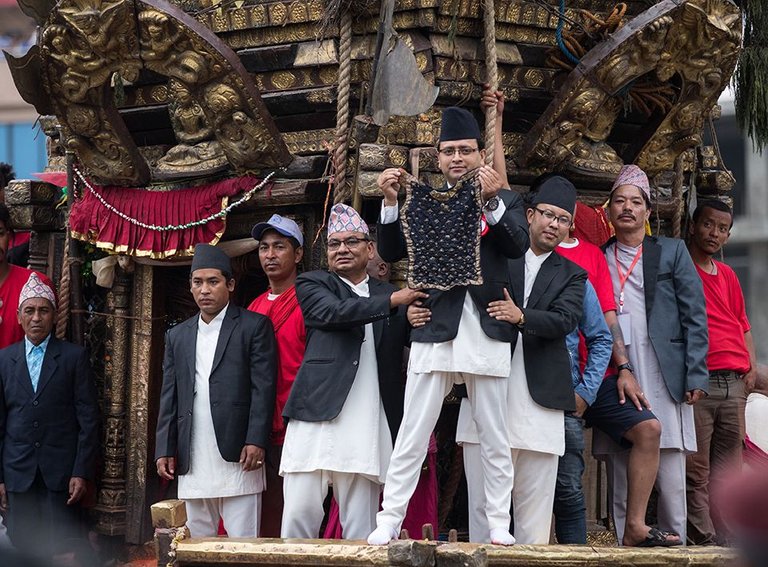Just before the starting of monsoon season, Rato Machhindranath Jatra is celebrated by pulling a chariot around Patan, Nepal. It is celebrated by paying homage to the God of Rain in hopes of good rain so that the city will get plenty rainfall for good growth of crops which leads to good harvest. The word Jatra means festival in Nepali and Rato Machhindranath Jatra is one of the oldest and longest festival celebrated in Lalitpur (historically known as Patan). Machhindranath (or Bunga Dyah in Newari) is the God of Rain and the word Rato Machhindra was derived as a result of the red colour of the deity’s idol.

Source
A 60 feet high chariot is constructed of cane, bamboo, wood in Pulchowk, Lalitpur and is beautifully decorated, inside which resides the idol of Rato Machhindranath. Another small chariot, Minnath (embodiment of Lord Shiva) is also pulled during this festival. The chariot is tugged around the city with the help of two strong ropes to keep its balance and is slowly circled around the city via Natole, Gabahal, Mangal Bazaar, Sundhara, Lagankhel, Kumaripati and finally ending at Jawalakhel.
Thousands of men and women crowd the street to celebrate this very special occasion. The chariots are accompanied by music played by traditional instruments such as Dhimay (traditional drums) and Bhusyah (brass cymbals). Three rounds of bullet are fired in air every time the chariot reaches a specific location. Street vendors take advantage of the pristine location and set up shop for the next day. There are thousands of devotees who line up offering prayers and hope to get a glimpse of the beautiful God inside the chariot.

There are many interesting moments during this festival, one of the main focuses is the coconut dropping part. After the chariot reaches a place called Thatitole, Lagankhel, a coconut is thrown from the top of the chariot. It is believed that whoever grabs the coconut will have his wishes fulfilled and will also be blessed with a baby boy. The next morning, the chariot is pulled only by women.

This festival ends with Bhoto Jatra. In Nepali, Bhoto means the inner vest. On the fourth day when the chariot reaches Jawalakhel, bejewelled Bhoto is displayed publicly in the presence of Patan’s living Goddess (Kumari) and the head of state (previously it used to be the King before abolition of monarchy system in Nepal). Thousands of people throng to witness the grand Bhoto as it is believed that getting a glimpse of the Bhoto brings good luck.

Source
After Bhoto Jatra, Rato Machhindranath is returned to the temple of Bungmati and the chariot is disassembled in Jawalakhel. If you happen to visit Nepal during mid-May, just before the monsoon, you will get an opportunity to witness this spectacular Jatra.
HISTORY
Every Jatra has its own story. Rato Machhindranath is believed to have been brought from Assam when Kathmandu was suffering from a long drought. The valley was then blessed with rain and is thus known as the valley’s God of rain.
The legend behind Bhoto Jatra comes from the story in which a farmer was gifted a diamond encrusted vest in gratitude by the Karkotaka Nag for curing the eye ailment of his Queen. The farmer wore that bhoto everywhere he went, which caught the eyes of everybody in the valley. One day, a ghost saw the farmer wearing the bhoto and he began to turn green with envy and secretly followed the farmer everywhere. Finally, his actions proved rewarding when one day, the farmer put aside his vest to work on his farm. Seizing this opportunity, the ghost stole the bhoto and ran away. The farmer tried to chase the ghost but failed as the ghost was too quick and clever. On his search for the bhoto, he stumbled across the Rato Machhindranath festival hoping the ghost would be there too. Luckily, he found the ghost wearing the same vest among the crowd which resulted in a quarrel between the ghost and the farmer. Coincidentally, King Guna Kamadev was also present there and he wanted to know why they were quarrelling. The guards of the king got hold of the arguing farmer and the ghost; and were presented before the king. The King listened to both sides of the story and both told their version of the story. As the king could not decide whose bhoto it was so he decided that the bhoto would be with the priests of Rato Machhindranath until someone brought proof of whose vest it was. None of them could prove it, therefore it has remained in the custody of the deity.
This is the reason why the bhoto is shown on the last day of Rato Machhindranath Jatra to the public, in a hope that the owner will come forward with the evidence to claim it.
really interesting tradition you have, we have something similar where people gather like this some brings the image image of a saint called St. Nino. It is believed in our religion that the saint can hell kinds of sufferings.
Though I am not religious, the interesting stories of religions and traditions somehow fascinates me.
Differences between us are what make life so interesting, we get to learn about new cultures and religions.
btw, thanks for dropping by my page! hope to see you around more!
Yea sure, can we connect?😀
Yay! 🤗
Your content has been boosted with Ecency Points, by @sagardyola.
Use Ecency daily to boost your growth on platform!
Support Ecency
Vote for Proposal
Delegate HP and earn more
👏👏👏
Wow, so many people! I bet it takes a lot of time to clean up that leftover mess! 🤭
All the local people help each other to clean the street after the festival.